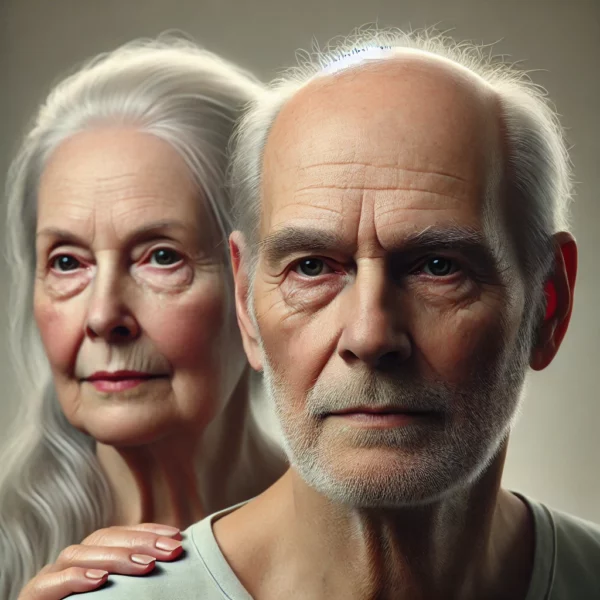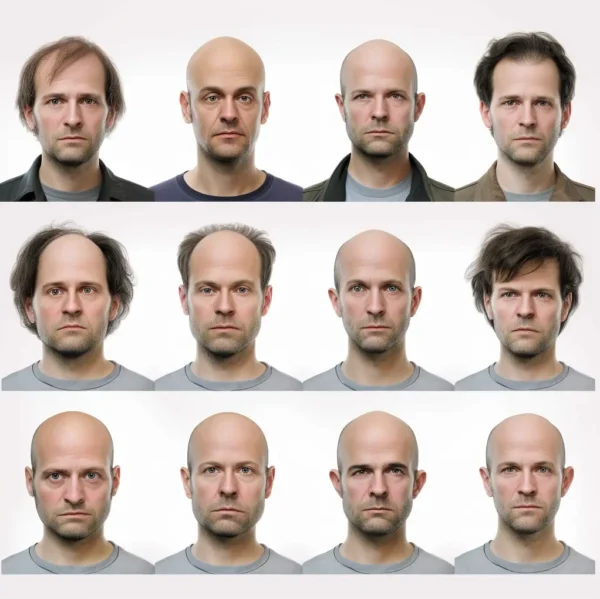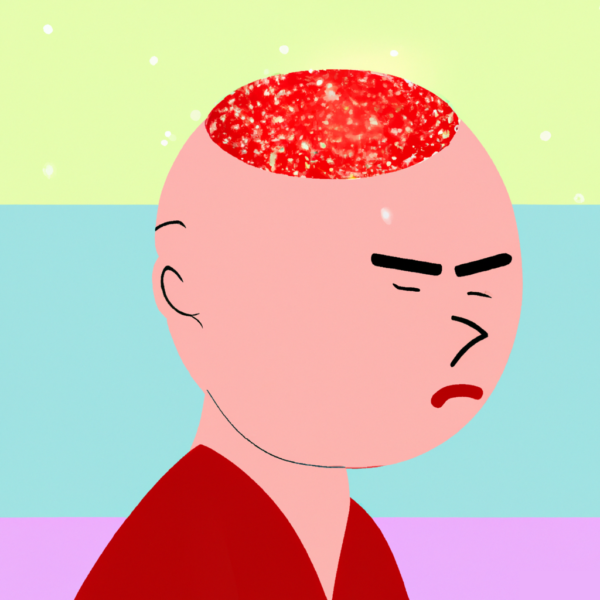There are dermatologists who regard pattern hair loss / androgenetic alopecia (AGA) as a disease and there are others who believe it is simply a part of the aging process. The debate surrounding whether AGA is a disease or a natural part of the aging process is both complex and nuanced, influenced by differing interpretations of what constitutes a disease and the societal implications of hair loss.
Definitions and Interpretations of Disease: The term “disease” can be interpreted in multiple ways, each offering a distinct perspective on AGA. There are two somewhat different dictionary interpretations of the word disease.
1) The first interpretation defines a dis-ease as something that causes discomfort, trouble, inconvenience, or is dangerous to the individual. Androgenetic alopecia is not painful and does not limit the individual’s physical ability to live their life as might other life threatening and life limiting diseases. However, it can lead to significant emotional and psychological discomfort due to societal pressures and the high value placed on appearance. This form of emotional distress, although profound, is subjective and varies widely among individuals. Under this definition, pattern hair loss may not strictly qualify as a disease since it does not impede physical function or pose a direct threat to physical health (though there are indirect links to heart disease, diabetes, etc.).
2) The second interpretation of dis-ease describes it as a specific destructive process in an organ or organism, with a specific cause and identifiable symptoms. This interpretation of the word “disease” fits with all that we know about androgenetic alopecia. The condition involves a progressive miniaturization of hair follicles, primarily driven by genetic and hormonal factors, particularly dihydrotestosterone (DHT). Long term androgenetic alopecia will lead to total and irreversible hair follicle destruction. So, my personal view is that androgenetic alopecia is a disease – albeit not physically a life threatening one. From a pathological standpoint, AGA can be viewed as a disease because it involves a specific, identifiable process that results in the destruction of hair follicles.
The fact that pattern hair loss is so common in the middle aged and elderly does not automatically prove that androgenetic alopecia is part of the natural aging process. Indeed, androgenetic alopecia need not develop in an individual – even if they are genetically predisposed towards development.
Androgenetic Alopecia as a Pathological Condition: AGA is a genetically mediated condition, with both men and women susceptible to its effects. The primary mechanism of development involves the conversion of testosterone to DHT by the enzyme 5-alpha reductase. DHT binds to androgen receptors in hair follicles, which activates a cascade of intracellular signals, as well as production of hair growth inhibiting factors that are secreted and signal to adjacent cells. Over time this DHT activation and downstream signaling results in hair follicle dermal papilla cells entering early senescence and dying off, leading to the gradual miniaturization of these follicles. This process results in the production of thinner and shorter hair shafts, eventually culminating in the cessation of hair production.
Scientific research supports the view of AGA as a disease. Studies have identified genetic loci associated with AGA, particularly variations in the androgen receptor gene. Additionally, research has highlighted the role of inflammation and other active biological pathways in the progression of AGA. These findings highlight the complex interplay of genetic, hormonal, and environmental factors in the pathogenesis of AGA, aligning it with the second definition of disease as a destructive biological process.
As disease, there are practical and potential therapeutic interventions that can block its development. Interfering with the production of DHT using 5-alpha reductase inhibitors or direct anti-androgens are one option. Anti-inflammatory agents are an additional treatment possibility. While the results of using these interventions may be suboptimal, the fact that they have at least some effect confirms that pattern hair loss is an active biological process. Something that could be fully prevented – if only we could develop the perfect interference drugs.
Androgenetic Alopecia and Aging: While AGA is commonly observed in middle-aged and older individuals, its association with aging does not necessarily confirm it as part of a natural aging process. Unlike other age-related changes, such as graying hair or skin wrinkling, AGA involves a specific pathological mechanism. Aging itself is characterized by a general decline in physiological function and cellular regeneration, affecting all individuals to varying degrees. In contrast, AGA selectively affects those with a genetic predisposition and follows a distinct biological pathway.
Moreover, the onset and progression of AGA can vary significantly among individuals, further distinguishing it from other universal signs of aging. Some individuals may experience AGA in their early twenties, while others may never develop significant hair loss despite advancing age. This variability emphasises the role of specific genetic and hormonal factors rather than a uniform aging process. A few studies looking at pattern hair loss in identical twins have shown that sometimes one twin can have much more extensive hair loss than the other. This is likely due to one twin’s exposure to environmental factors that accelerate their androgen hormone activity. What these environmental factors are is less clear, but probably includes things such as smoking, poor diet, high stress, chronic inflammation, and possibly even high levels of pollution.
Hair loss is part of aging for many of us, but it is a different type of hair loss called “Involutional Alopecia” or simply “Alopecia of the Aged”. In the past it was also sometimes called “Senile Alopecia” and “Geriatric Alopecia”, but these terms are no longer used given they are somewhat offensive. This type of hair loss is a diffuse alopecia that occurs in both elderly men and women. The hair loss is a result of the general loss of vitality that occurs in all cells as we get older, and does not involve androgen hormone activity.
Emotional and Psychological Impact: The emotional and psychological impact of AGA is a critical aspect of the debate. Hair loss can lead to diminished self-esteem, social anxiety, and even depression. These effects are exacerbated by societal norms (in our current society at least) and cultural values that equate hair with youth, vitality, and attractiveness. The psychological burden of AGA can be substantial, affecting an individual’s quality of life and mental health.
From this perspective, AGA shares similarities with other chronic conditions that, while not life-threatening, significantly impact emotional well-being. The stigma associated with hair loss can lead individuals to seek various treatments, including medications like minoxidil and finasteride, hair transplant surgeries, and cosmetic solutions. The demand for these treatments highlights the significance of the negative psychological impact of AGA and also supports the argument for its classification as a disease.
Conclusion: The question of whether androgenetic alopecia is a disease or part of the natural aging process does not have a straightforward answer. It depends on the interpretation of the term “disease” and the perspective from which one views AGA. From a pathological standpoint, AGA fits the criteria of a disease due to its specific biological mechanism and destructive impact on hair follicles. Conversely, considering its non-life-threatening nature and the subjective nature of its emotional impact, some may argue that it is a part of the natural aging process, albeit one that disproportionately affects certain individuals.
Ultimately, the classification of AGA may benefit from a more nuanced understanding that acknowledges both its biological basis and its significant psychological ramifications. Recognizing AGA as a disease could help reduce the stigma associated with hair loss and promote a more compassionate approach to those affected. Understanding its biological mechanism, and its (lack of) relationship with aging, can inform better management and support strategies for individuals coping with this common condition.
Bibliography
11711645 {11711645:VVQRPZ8A},{11711645:QW7D3T5I},{11711645:GI5PF635},{11711645:5IEIDRFB},{11711645:VV627BW8},{11711645:7QJ9KDCS},{11711645:Z5UNJ2C7},{11711645:AQAXN7GF},{11711645:ZFHIP836},{11711645:IE4UF936},{11711645:MV5FKWHB} 1 vancouver 50 date asc 1574 https://www.keratin.com/wp-content/plugins/zotpress/ %7B%22status%22%3A%22success%22%2C%22updateneeded%22%3Afalse%2C%22instance%22%3Afalse%2C%22meta%22%3A%7B%22request_last%22%3A0%2C%22request_next%22%3A0%2C%22used_cache%22%3Atrue%7D%2C%22data%22%3A%5B%7B%22key%22%3A%225IEIDRFB%22%2C%22library%22%3A%7B%22id%22%3A11711645%7D%2C%22meta%22%3A%7B%22creatorSummary%22%3A%22Randall1%20et%20al.%22%2C%22parsedDate%22%3A%221996-03%22%2C%22numChildren%22%3A0%7D%2C%22bib%22%3A%22%3Cdiv%20class%3D%5C%22csl-bib-body%5C%22%20style%3D%5C%22line-height%3A%201.35%3B%20%5C%22%3E%5Cn%20%20%3Cdiv%20class%3D%5C%22csl-entry%5C%22%20style%3D%5C%22clear%3A%20left%3B%20%5C%22%3E%5Cn%20%20%20%20%3Cdiv%20class%3D%5C%22csl-left-margin%5C%22%20style%3D%5C%22float%3A%20left%3B%20padding-right%3A%200.5em%3B%20text-align%3A%20right%3B%20width%3A%201em%3B%5C%22%3E1.%3C%5C%2Fdiv%3E%3Cdiv%20class%3D%5C%22csl-right-inline%5C%22%20style%3D%5C%22margin%3A%200%20.4em%200%201.5em%3B%5C%22%3ERandall1%20VA%2C%20Hibberts%20NA%2C%20Hamada%20K.%20A%20comparison%20of%20the%20culture%20and%20growth%20of%20dermal%20papilla%20cells%20from%20hair%20follicles%20from%20non-balding%20and%20balding%20%28androgenetic%20alopecia%29%20scalp.%20Br%20J%20Dermatol.%201996%20Mar%3B134%283%29%3A437%26%23x2013%3B44.%3C%5C%2Fdiv%3E%5Cn%20%20%20%3C%5C%2Fdiv%3E%5Cn%3C%5C%2Fdiv%3E%22%2C%22data%22%3A%7B%22itemType%22%3A%22journalArticle%22%2C%22title%22%3A%22A%20comparison%20of%20the%20culture%20and%20growth%20of%20dermal%20papilla%20cells%20from%20hair%20follicles%20from%20non-balding%20and%20balding%20%28androgenetic%20alopecia%29%20scalp%22%2C%22creators%22%3A%5B%7B%22creatorType%22%3A%22author%22%2C%22firstName%22%3A%22V.%20A.%22%2C%22lastName%22%3A%22Randall1%22%7D%2C%7B%22creatorType%22%3A%22author%22%2C%22firstName%22%3A%22N.%20A.%22%2C%22lastName%22%3A%22Hibberts%22%7D%2C%7B%22creatorType%22%3A%22author%22%2C%22firstName%22%3A%22K.%22%2C%22lastName%22%3A%22Hamada%22%7D%5D%2C%22abstractNote%22%3A%22Male%20pattern%20baldness%20is%20a%20common%2C%20androgen-dependent%20skin%20problem%20in%20adult%20men%20which%20is%20not%20well%20understood%2C%20although%20androgens%20are%20believed%20to%20act%20on%20the%20hair%20follicle%20via%20the%20mesenchyme-derived%20dermal%20papilla%20situated%20in%20the%20middle%20of%20the%20hair%20follicle%20bulb.%20Since%20dermal%20papilla%20cells%20retain%20specific%20characteristics%20in%20culture%2C%20such%20as%20hair-growth%20promoting%20ability%20and%20appropriate%20features%20of%20the%20mechanism%20of%20androgen%20action%2C%20dermal%20papilla%20cells%20from%20follicles%20undergoing%20androgen-stimulated%20miniaturization%20may%20provide%20a%20useful%20in%20vitro%20model%20system.%20Therefore%2C%20dermal%20papilla%20cells%20have%20been%20derived%20from%20intermediate%20follicles%20from%20balding%20and%20nearly%20clinically%20normal%20sites%20of%20men%20with%20androgenetic%20alopecia.%20Balding%20dermal%20papillae%20were%20much%20smaller%20than%20non-balding%20ones%20and%20grew%20much%20less%20well%20under%20normal%20growth%20conditions.%20Supplementing%20the%20medium%20with%20human%20serum%2C%20rather%20than%20fetal%20calf%20serum%2C%20increased%20both%20the%20yield%20of%20established%20cultures%20and%20the%20number%20and%20health%20of%20the%20dermal%20papilla%20cells%20produced.%20Non-balding%20cells%20also%20grew%20faster%20in%20human%20serum.%20Balding%20cells%20retained%20the%20normal%20fibroblastic%20shape%20and%20aggregative%20behaviour%20of%20dermal%20papilla%20cells%2C%20but%20always%20grew%20less%20well%20than%20non-balding%20cells.%20Nearly%20clinically%20normal%20dermal%20papillae%20were%20similar%2C%20or%20slightly%20smaller%2C%20in%20size%20to%20non-balding%20ones%2C%20but%20their%20growth%20resembled%20balding%20cells.%20Since%20balding%20dermal%20papilla%20cells%20can%20be%20cultured%2C%20though%20with%20much%20greater%20difficulty%20than%20nonbalding%20ones%2C%20and%20exhibit%20differing%20growth%20characteristics%20to%20non-balding%20cells%2C%20they%20merit%20further%20investigation%20which%20may%20increase%20our%20understanding%20of%2C%20and%20ability%20to%20control%2C%20androgenetic%20alopecia.%22%2C%22date%22%3A%221996-03%22%2C%22language%22%3A%22eng%22%2C%22DOI%22%3A%22%22%2C%22ISSN%22%3A%220007-0963%22%2C%22url%22%3A%22%22%2C%22collections%22%3A%5B%223VIUZPRU%22%5D%2C%22dateModified%22%3A%222024-07-20T14%3A35%3A50Z%22%7D%7D%2C%7B%22key%22%3A%22VV627BW8%22%2C%22library%22%3A%7B%22id%22%3A11711645%7D%2C%22meta%22%3A%7B%22creatorSummary%22%3A%22Randall%20et%20al.%22%2C%22parsedDate%22%3A%222001%22%2C%22numChildren%22%3A0%7D%2C%22bib%22%3A%22%3Cdiv%20class%3D%5C%22csl-bib-body%5C%22%20style%3D%5C%22line-height%3A%201.35%3B%20%5C%22%3E%5Cn%20%20%3Cdiv%20class%3D%5C%22csl-entry%5C%22%20style%3D%5C%22clear%3A%20left%3B%20%5C%22%3E%5Cn%20%20%20%20%3Cdiv%20class%3D%5C%22csl-left-margin%5C%22%20style%3D%5C%22float%3A%20left%3B%20padding-right%3A%200.5em%3B%20text-align%3A%20right%3B%20width%3A%201em%3B%5C%22%3E1.%3C%5C%2Fdiv%3E%3Cdiv%20class%3D%5C%22csl-right-inline%5C%22%20style%3D%5C%22margin%3A%200%20.4em%200%201.5em%3B%5C%22%3ERandall%20VA%2C%20Hibberts%20NA%2C%20Thornton%20MJ%2C%20Merrick%20AE%2C%20Hamada%20K%2C%20Kato%20S%2C%20et%20al.%20Do%20androgens%20influence%20hair%20growth%20by%20altering%20the%20paracrine%20factors%20secreted%20by%20dermal%20papilla%20cells%3F%20Eur%20J%20Dermatol.%202001%3B11%284%29%3A315%26%23x2013%3B20.%3C%5C%2Fdiv%3E%5Cn%20%20%20%3C%5C%2Fdiv%3E%5Cn%3C%5C%2Fdiv%3E%22%2C%22data%22%3A%7B%22itemType%22%3A%22journalArticle%22%2C%22title%22%3A%22Do%20androgens%20influence%20hair%20growth%20by%20altering%20the%20paracrine%20factors%20secreted%20by%20dermal%20papilla%20cells%3F%22%2C%22creators%22%3A%5B%7B%22creatorType%22%3A%22author%22%2C%22firstName%22%3A%22V.%20A.%22%2C%22lastName%22%3A%22Randall%22%7D%2C%7B%22creatorType%22%3A%22author%22%2C%22firstName%22%3A%22N.%20A.%22%2C%22lastName%22%3A%22Hibberts%22%7D%2C%7B%22creatorType%22%3A%22author%22%2C%22firstName%22%3A%22M.%20J.%22%2C%22lastName%22%3A%22Thornton%22%7D%2C%7B%22creatorType%22%3A%22author%22%2C%22firstName%22%3A%22A.%20E.%22%2C%22lastName%22%3A%22Merrick%22%7D%2C%7B%22creatorType%22%3A%22author%22%2C%22firstName%22%3A%22K.%22%2C%22lastName%22%3A%22Hamada%22%7D%2C%7B%22creatorType%22%3A%22author%22%2C%22firstName%22%3A%22S.%22%2C%22lastName%22%3A%22Kato%22%7D%2C%7B%22creatorType%22%3A%22author%22%2C%22firstName%22%3A%22T.%20J.%22%2C%22lastName%22%3A%22Jenner%22%7D%2C%7B%22creatorType%22%3A%22author%22%2C%22firstName%22%3A%22I.%22%2C%22lastName%22%3A%22de%20Oliveira%22%7D%2C%7B%22creatorType%22%3A%22author%22%2C%22firstName%22%3A%22A.%20G.%22%2C%22lastName%22%3A%22Messenger%22%7D%5D%2C%22abstractNote%22%3A%22Androgens%20regulate%20many%20aspects%20of%20human%20hair%20growth%20in%20both%20sexes.%20After%20puberty%20they%20transform%20tiny%20vellus%20follicles%20in%20many%20areas%2C%20e.g.%20the%20face%2C%20to%20terminal%20ones%20producing%20long%2C%20thick%2C%20pigmented%20hairs.%20In%20genetically%20predisposed%20individuals%2C%20androgens%20also%20cause%20the%20reverse%20transformation%20of%20terminal%20scalp%20follicles%20into%20vellus%20ones%2C%20causing%20balding.%20In%20the%20current%20hypothesis%20for%20androgen%20action%2C%20androgens%20control%20most%20follicular%20cells%20indirectly%20acting%20via%20the%20mesenchyme-derived%20dermal%20papilla%20which%20regulates%20many%20aspects%20of%20follicular%20activity.%20In%20this%20model%20androgens%20binding%20to%20androgen%20receptors%20in%20dermal%20papilla%20cells%20alter%20their%20production%20of%20regulatory%20molecules%20which%20influence%20other%20follicular%20components%3B%20these%20molecules%20may%20be%20soluble%20paracrine%20factors%20and%5C%2For%20extracellular%20matrix%20proteins.%20This%20hypothesis%20is%20supported%20by%20immunohistochemical%20localisation%20of%20androgen%20receptors%20in%20dermal%20papilla%20cell%20nuclei%20and%20the%20demonstrations%20that%20androgen%20receptor%20content%20and%20testosterone%20metabolism%20patterns%20of%20cultured%20dermal%20papilla%20cells%20from%20various%20body%20sites%20reflect%20hair%20growth%20in%20androgen-insensitivity%20syndromes.%20The%20next%20question%20is%20whether%20androgens%20alter%20the%20paracrine%20factors%20secreted%20by%20dermal%20papilla%20cells.%20Cultured%20dermal%20papilla%20cells%20do%20release%20soluble%2C%20proteinaceous%20factors%20into%20their%20media%20which%20stimulate%20the%20growth%20of%20keratinocytes%20and%20other%20dermal%20papilla%20cells.%20This%20mitogenic%20potential%20can%20cross%20species%20from%20humans%20to%20rodents.%20Importantly%2C%20testosterone%20in%20vitro%20stimulates%20the%20mitogenic%20potential%20of%20beard%20cells%2C%20but%20in%20contrast%20inhibits%20production%20by%20balding%20scalp%20cells%20reflecting%20their%20in%20vivo%20androgenic%20responses.%20Since%20androgens%20in%20vitro%20do%20alter%20the%20secretion%20of%20paracrine%20factors%20the%20current%20focus%20lies%20in%20identifying%20specific%20factors%20produced%2C%20e.g.%20IGF-I%20and%20stem%20cell%20factor%20%28SCF%29%2C%20using%20ELISA%20and%20RT-PCR%2C%20and%20comparing%20their%20expression%20in%20cells%20from%20follicles%20with%20varying%20responses%20to%20androgens%20in%20vivo%20or%20under%20androgen%20stimulation%20in%20vitro.%20This%20should%20lead%20to%20greater%20understanding%20of%20androgen%20action%20and%20enable%20the%20development%20of%20better%20treatment%20for%20androgen-potentiated%20disorders.%22%2C%22date%22%3A%222001%22%2C%22language%22%3A%22eng%22%2C%22DOI%22%3A%22%22%2C%22ISSN%22%3A%221167-1122%22%2C%22url%22%3A%22%22%2C%22collections%22%3A%5B%223VIUZPRU%22%5D%2C%22dateModified%22%3A%222024-07-20T14%3A17%3A58Z%22%7D%7D%2C%7B%22key%22%3A%22Z5UNJ2C7%22%2C%22library%22%3A%7B%22id%22%3A11711645%7D%2C%22meta%22%3A%7B%22creatorSummary%22%3A%22Tosti%20et%20al.%22%2C%22parsedDate%22%3A%222005-01%22%2C%22numChildren%22%3A0%7D%2C%22bib%22%3A%22%3Cdiv%20class%3D%5C%22csl-bib-body%5C%22%20style%3D%5C%22line-height%3A%201.35%3B%20%5C%22%3E%5Cn%20%20%3Cdiv%20class%3D%5C%22csl-entry%5C%22%20style%3D%5C%22clear%3A%20left%3B%20%5C%22%3E%5Cn%20%20%20%20%3Cdiv%20class%3D%5C%22csl-left-margin%5C%22%20style%3D%5C%22float%3A%20left%3B%20padding-right%3A%200.5em%3B%20text-align%3A%20right%3B%20width%3A%201em%3B%5C%22%3E1.%3C%5C%2Fdiv%3E%3Cdiv%20class%3D%5C%22csl-right-inline%5C%22%20style%3D%5C%22margin%3A%200%20.4em%200%201.5em%3B%5C%22%3ETosti%20A%2C%20Piraccini%20BM%2C%20Iorizzo%20M%2C%20Voudouris%20S.%20The%20natural%20history%20of%20androgenetic%20alopecia.%20J%20Cosmet%20Dermatol.%202005%20Jan%3B4%281%29%3A41%26%23x2013%3B3.%3C%5C%2Fdiv%3E%5Cn%20%20%20%3C%5C%2Fdiv%3E%5Cn%3C%5C%2Fdiv%3E%22%2C%22data%22%3A%7B%22itemType%22%3A%22journalArticle%22%2C%22title%22%3A%22The%20natural%20history%20of%20androgenetic%20alopecia%22%2C%22creators%22%3A%5B%7B%22creatorType%22%3A%22author%22%2C%22firstName%22%3A%22A.%22%2C%22lastName%22%3A%22Tosti%22%7D%2C%7B%22creatorType%22%3A%22author%22%2C%22firstName%22%3A%22B.%20M.%22%2C%22lastName%22%3A%22Piraccini%22%7D%2C%7B%22creatorType%22%3A%22author%22%2C%22firstName%22%3A%22M.%22%2C%22lastName%22%3A%22Iorizzo%22%7D%2C%7B%22creatorType%22%3A%22author%22%2C%22firstName%22%3A%22S.%22%2C%22lastName%22%3A%22Voudouris%22%7D%5D%2C%22abstractNote%22%3A%22Androgenetic%20alopecia%20%28AGA%29%20is%20the%20most%20common%20cause%20of%20hair%20loss%2C%20affecting%20up%20to%2080%25%20of%20men%20and%2050%25%20of%20women%20in%20their%20lifetime.%20Genetic%20predisposition%20to%20the%20disease%20is%20well%20known%20but%20the%20responsible%20genes%20have%20not%20been%20identified.%20Polymorphism%20in%20the%20androgen%20receptor%20gene%20has%20been%20recently%20detected%20in%20AGA.%281%29%20Although%20the%20role%20of%20androgens%2C%20and%20particularly%20dihydrotestosterone%20%28DHT%29%2C%20in%20causing%20the%20disease%20has%20been%20established%20for%20a%20long%20time%2C%20the%20natural%20history%20of%20AGA%20is%20still%20not%20completely%20understood.%20This%20paper%20reviews%20recent%20data%20about%20natural%20progression%20of%20the%20disease%2C%20as%20well%20as%20factors%20that%20may%20interfere%20with%20its%20course%20and%20long-term%20prognosis.%22%2C%22date%22%3A%222005-01%22%2C%22language%22%3A%22eng%22%2C%22DOI%22%3A%2210.1111%5C%2Fj.1473-2165.2005.00158.x%22%2C%22ISSN%22%3A%221473-2165%22%2C%22url%22%3A%22%22%2C%22collections%22%3A%5B%223VIUZPRU%22%5D%2C%22dateModified%22%3A%222024-07-20T14%3A37%3A16Z%22%7D%7D%2C%7B%22key%22%3A%22VVQRPZ8A%22%2C%22library%22%3A%7B%22id%22%3A11711645%7D%2C%22meta%22%3A%7B%22creatorSummary%22%3A%22Hamada%20and%20Randall%22%2C%22parsedDate%22%3A%222006-04%22%2C%22numChildren%22%3A0%7D%2C%22bib%22%3A%22%3Cdiv%20class%3D%5C%22csl-bib-body%5C%22%20style%3D%5C%22line-height%3A%201.35%3B%20%5C%22%3E%5Cn%20%20%3Cdiv%20class%3D%5C%22csl-entry%5C%22%20style%3D%5C%22clear%3A%20left%3B%20%5C%22%3E%5Cn%20%20%20%20%3Cdiv%20class%3D%5C%22csl-left-margin%5C%22%20style%3D%5C%22float%3A%20left%3B%20padding-right%3A%200.5em%3B%20text-align%3A%20right%3B%20width%3A%201em%3B%5C%22%3E1.%3C%5C%2Fdiv%3E%3Cdiv%20class%3D%5C%22csl-right-inline%5C%22%20style%3D%5C%22margin%3A%200%20.4em%200%201.5em%3B%5C%22%3EHamada%20K%2C%20Randall%20VA.%20Inhibitory%20autocrine%20factors%20produced%20by%20the%20mesenchyme-derived%20hair%20follicle%20dermal%20papilla%20may%20be%20a%20key%20to%20male%20pattern%20baldness.%20Br%20J%20Dermatol.%202006%20Apr%3B154%284%29%3A609%26%23x2013%3B18.%3C%5C%2Fdiv%3E%5Cn%20%20%20%3C%5C%2Fdiv%3E%5Cn%3C%5C%2Fdiv%3E%22%2C%22data%22%3A%7B%22itemType%22%3A%22journalArticle%22%2C%22title%22%3A%22Inhibitory%20autocrine%20factors%20produced%20by%20the%20mesenchyme-derived%20hair%20follicle%20dermal%20papilla%20may%20be%20a%20key%20to%20male%20pattern%20baldness%22%2C%22creators%22%3A%5B%7B%22creatorType%22%3A%22author%22%2C%22firstName%22%3A%22K.%22%2C%22lastName%22%3A%22Hamada%22%7D%2C%7B%22creatorType%22%3A%22author%22%2C%22firstName%22%3A%22V.%20A.%22%2C%22lastName%22%3A%22Randall%22%7D%5D%2C%22abstractNote%22%3A%22BACKGROUND%3A%20Androgenetic%20alopecia%2C%20or%20male%20pattern%20baldness%2C%20is%20a%20common%2C%20progressive%20disorder%20where%20large%2C%20terminal%20scalp%20hairs%20are%20gradually%20replaced%20by%20smaller%20hairs%20in%20precise%20patterns%20until%20only%20tiny%20vellus%20hairs%20remain.%20This%20balding%20can%20cause%20a%20marked%20reduction%20in%20the%20quality%20of%20life.%20Although%20these%20changes%20are%20driven%20by%20androgens%2C%20most%20molecular%20mechanisms%20are%20unknown%2C%20limiting%20available%20treatments.%20The%20mesenchyme-derived%20dermal%20papilla%20at%20the%20base%20of%20the%20mainly%20epithelial%20hair%20follicle%20controls%20the%20type%20of%20hair%20produced%20and%20is%20probably%20the%20site%20through%20which%20androgens%20act%20on%20follicle%20cells%20by%20altering%20the%20regulatory%20paracrine%20factors%20produced%20by%20dermal%20papilla%20cells.%20During%20changes%20in%20hair%20size%20the%20relationship%20between%20the%20hair%20and%20dermal%20papilla%20size%20remains%20constant%2C%20with%20alterations%20in%20both%20dermal%20papilla%20volume%20and%20cell%20number.%20This%20suggests%20that%20alterations%20within%20the%20dermal%20papilla%20itself%20play%20a%20key%20role%20in%20altering%20hair%20size%20in%20response%20to%20androgens.%20Cultured%20dermal%20papilla%20cells%20offer%20a%20useful%20model%20system%20to%20investigate%20this%20as%20they%20promote%20new%20hair%20growth%20in%20vivo%2C%20retain%20characteristics%20in%20vitro%20which%20reflect%20their%20parent%20follicle%27s%20response%20to%20androgens%20in%20vivo%20and%20secrete%20mitogenic%20factors%20for%20dermal%20papilla%20cells%20and%20keratinocytes.%5CnOBJECTIVES%3A%20To%20investigate%20whether%20cultured%20dermal%20papilla%20cells%20from%20balding%20follicles%20secrete%20altered%20amounts%5C%2Ftypes%20of%20mitogenic%20factors%20for%20dermal%20papilla%20cells%20than%20those%20from%20larger%2C%20normal%20follicles.%20We%20also%20aimed%20to%20determine%20whether%20rodent%20cells%20would%20recognize%20mitogenic%20signals%20from%20human%20cells%20in%20vitro%20and%20whether%20factors%20produced%20by%20balding%20dermal%20papilla%20cells%20could%20alter%20the%20start%20of%20a%20new%20mouse%20hair%20cycle%20in%20vivo.%5CnMETHODS%3A%20Dermal%20papilla%20cells%20were%20cultured%20from%20normal%2C%20balding%20and%20almost%20clinically%20normal%20areas%20of%20balding%20scalps%20and%20their%20ability%20to%20produce%20mitogenic%20factors%20compared%20using%20both%20human%20and%20rat%20whisker%20dermal%20papilla%20cells%20as%20in%20vitro%20targets%20and%20mouse%20hair%20growth%20in%20vivo.%5CnRESULTS%3A%20Normal%20scalp%20cells%20produced%20soluble%20factors%20which%20stimulated%20the%20growth%20of%20both%20human%20scalp%20and%20rat%20whisker%20dermal%20papilla%20cells%20in%20vitro%2C%20demonstrating%20dose-responsive%20mitogenic%20capability%20across%20species.%20Although%20balding%20cells%20stimulated%20some%20growth%2C%20this%20was%20much%20reduced%20and%20they%20also%20secreted%20inhibitory%20factor%28s%29.%20Balding%20cell%20media%20also%20delayed%20new%20hair%20growth%20when%20injected%20into%20mice.%5CnCONCLUSIONS%3A%20Human%20balding%20dermal%20papilla%20cells%20secrete%20inhibitory%20factors%20which%20affect%20the%20growth%20of%20both%20human%20and%20rodent%20dermal%20papilla%20cells%20and%20factors%20which%20delay%20the%20onset%20of%20anagen%20in%20mice%20in%20vivo.%20These%20inhibitory%20factor%28s%29%20probably%20cause%20the%20formation%20of%20smaller%20dermal%20papillae%20and%20smaller%20hairs%20in%20male%20pattern%20baldness.%20Identification%20of%20such%20factor%28s%29%20could%20lead%20to%20novel%20therapeutic%20approaches.%22%2C%22date%22%3A%222006-04%22%2C%22language%22%3A%22eng%22%2C%22DOI%22%3A%2210.1111%5C%2Fj.1365-2133.2006.07144.x%22%2C%22ISSN%22%3A%220007-0963%22%2C%22url%22%3A%22%22%2C%22collections%22%3A%5B%223VIUZPRU%22%5D%2C%22dateModified%22%3A%222024-07-20T14%3A17%3A32Z%22%7D%7D%2C%7B%22key%22%3A%22ZFHIP836%22%2C%22library%22%3A%7B%22id%22%3A11711645%7D%2C%22meta%22%3A%7B%22creatorSummary%22%3A%22Tr%5Cu00fceb%22%2C%22parsedDate%22%3A%222015%22%2C%22numChildren%22%3A0%7D%2C%22bib%22%3A%22%3Cdiv%20class%3D%5C%22csl-bib-body%5C%22%20style%3D%5C%22line-height%3A%201.35%3B%20%5C%22%3E%5Cn%20%20%3Cdiv%20class%3D%5C%22csl-entry%5C%22%20style%3D%5C%22clear%3A%20left%3B%20%5C%22%3E%5Cn%20%20%20%20%3Cdiv%20class%3D%5C%22csl-left-margin%5C%22%20style%3D%5C%22float%3A%20left%3B%20padding-right%3A%200.5em%3B%20text-align%3A%20right%3B%20width%3A%201em%3B%5C%22%3E1.%3C%5C%2Fdiv%3E%3Cdiv%20class%3D%5C%22csl-right-inline%5C%22%20style%3D%5C%22margin%3A%200%20.4em%200%201.5em%3B%5C%22%3ETr%26%23xFC%3Beb%20RM.%20Effect%20of%20ultraviolet%20radiation%2C%20smoking%20and%20nutrition%20on%20hair.%20Curr%20Probl%20Dermatol.%202015%3B47%3A107%26%23x2013%3B20.%3C%5C%2Fdiv%3E%5Cn%20%20%20%3C%5C%2Fdiv%3E%5Cn%3C%5C%2Fdiv%3E%22%2C%22data%22%3A%7B%22itemType%22%3A%22journalArticle%22%2C%22title%22%3A%22Effect%20of%20ultraviolet%20radiation%2C%20smoking%20and%20nutrition%20on%20hair%22%2C%22creators%22%3A%5B%7B%22creatorType%22%3A%22author%22%2C%22firstName%22%3A%22Ralph%20M.%22%2C%22lastName%22%3A%22Tr%5Cu00fceb%22%7D%5D%2C%22abstractNote%22%3A%22Similar%20to%20the%20rest%20of%20the%20skin%2C%20the%20hair%20is%20exposed%20to%20noxious%20environmental%20factors.%20While%20ultraviolet%20radiation%20%28UVR%29%20and%20smoking%20are%20well%20appreciated%20as%20major%20factors%20contributing%20to%20the%20extrinsic%20aging%20of%20the%20skin%2C%20their%20effects%20on%20the%20condition%20of%20hair%20have%20only%20lately%20attracted%20the%20attention%20of%20the%20medical%20community.%20Terrestrial%20solar%20UVR%20ranges%20from%20approximately%20290%20to%20400%20nm%3B%20UV-B%20%28290-315%20nm%29%20reaches%20only%20the%20upper%20dermis%2C%20while%20the%20penetration%20of%20UV-A%20%28315-400%20nm%29%20into%20the%20dermis%20increases%20with%20wavelength.%20The%20two%20most%20important%20chronic%20effects%20of%20UVR%20on%20the%20skin%20and%20bald%20scalp%20are%20photocarcinogenesis%20and%20solar%20elastosis%3B%20however%2C%20the%20effects%20of%20UVR%20on%20hair%20have%20largely%20been%20ignored.%20As%20a%20consequence%20of%20increased%20leisure%20time%20and%20a%20growing%20popularity%20of%20outdoor%20activities%20and%20holidays%20in%20the%20sun%2C%20the%20awareness%20of%20sun%20protection%20of%20the%20skin%20has%20become%20important%20and%20should%20also%20apply%20to%20the%20hair.%20Besides%20being%20the%20single-most%20preventable%20cause%20of%20significant%20cardiovascular%20and%20pulmonary%20morbidity%20and%20an%20important%20cause%20of%20death%2C%20the%20association%20of%20tobacco%20smoking%20with%20various%20adverse%20effects%20on%20the%20skin%20and%20hair%20has%20also%20been%20recognized.%20Increasing%20public%20awareness%20of%20the%20association%20between%20smoking%20and%20hair%20loss%20seems%20to%20offer%20a%20good%20opportunity%20for%20the%20prevention%20or%20cessation%20of%20smoking%2C%20since%20the%20appearance%20of%20hair%20plays%20an%20important%20role%20in%20the%20overall%20physical%20appearance%20and%20self-perception%20of%20people.%20Finally%2C%20the%20quantity%20and%20quality%20of%20hair%20are%20closely%20related%20to%20the%20nutritional%20state%20of%20an%20individual.%20Normal%20supply%2C%20uptake%2C%20and%20transport%20of%20proteins%2C%20calories%2C%20trace%20elements%2C%20and%20vitamins%20are%20of%20fundamental%20importance%20in%20tissues%20with%20high%20biosynthetic%20activity%2C%20such%20as%20the%20hair%20follicle.%20In%20instances%20of%20protein%20and%20calorie%20malnutrition%20as%20well%20as%20essential%20amino%20acid%2C%20trace%20element%2C%20and%20vitamin%20deficiencies%2C%20hair%20growth%20and%20pigmentation%20may%20be%20impaired.%20Ultimately%2C%20important%20commercial%20interest%20lies%20in%20the%20question%20of%20whether%20increasing%20the%20content%20of%20an%20already%20adequate%20diet%20with%20specific%20amino%20acids%2C%20vitamins%20and%5C%2For%20trace%20elements%20may%20further%20promote%20hair%20growth.%20Unless%20the%20hair%20is%20impaired%20due%20to%20nutritional%20deficiency%2C%20there%20is%20only%20so%20much%20that%20nutrients%20can%20do%20to%20increase%20the%20size%20of%20individual%20hairs%20because%20hair%20thickness%20is%20largely%20genetic.%20Nevertheless%2C%20there%20are%20external%20factors%20that%20influence%20hair%20health%20to%20such%20a%20degree%20that%20micronutrients%20could%20boost%20hair%20that%20is%20suffering%20from%20these%20problems.%22%2C%22date%22%3A%222015%22%2C%22language%22%3A%22eng%22%2C%22DOI%22%3A%2210.1159%5C%2F000369411%22%2C%22ISSN%22%3A%221662-2944%22%2C%22url%22%3A%22%22%2C%22collections%22%3A%5B%223VIUZPRU%22%5D%2C%22dateModified%22%3A%222024-07-20T14%3A37%3A58Z%22%7D%7D%2C%7B%22key%22%3A%22GI5PF635%22%2C%22library%22%3A%7B%22id%22%3A11711645%7D%2C%22meta%22%3A%7B%22creatorSummary%22%3A%22Mirmirani%22%2C%22parsedDate%22%3A%222015-01%22%2C%22numChildren%22%3A0%7D%2C%22bib%22%3A%22%3Cdiv%20class%3D%5C%22csl-bib-body%5C%22%20style%3D%5C%22line-height%3A%201.35%3B%20%5C%22%3E%5Cn%20%20%3Cdiv%20class%3D%5C%22csl-entry%5C%22%20style%3D%5C%22clear%3A%20left%3B%20%5C%22%3E%5Cn%20%20%20%20%3Cdiv%20class%3D%5C%22csl-left-margin%5C%22%20style%3D%5C%22float%3A%20left%3B%20padding-right%3A%200.5em%3B%20text-align%3A%20right%3B%20width%3A%201em%3B%5C%22%3E1.%3C%5C%2Fdiv%3E%3Cdiv%20class%3D%5C%22csl-right-inline%5C%22%20style%3D%5C%22margin%3A%200%20.4em%200%201.5em%3B%5C%22%3EMirmirani%20P.%20Age-related%20hair%20changes%20in%20men%3A%20mechanisms%20and%20management%20of%20alopecia%20and%20graying.%20Maturitas.%202015%20Jan%3B80%281%29%3A58%26%23x2013%3B62.%3C%5C%2Fdiv%3E%5Cn%20%20%20%3C%5C%2Fdiv%3E%5Cn%3C%5C%2Fdiv%3E%22%2C%22data%22%3A%7B%22itemType%22%3A%22journalArticle%22%2C%22title%22%3A%22Age-related%20hair%20changes%20in%20men%3A%20mechanisms%20and%20management%20of%20alopecia%20and%20graying%22%2C%22creators%22%3A%5B%7B%22creatorType%22%3A%22author%22%2C%22firstName%22%3A%22Paradi%22%2C%22lastName%22%3A%22Mirmirani%22%7D%5D%2C%22abstractNote%22%3A%22The%20appearance%20of%20human%20scalp%20hair%20is%20often%20tied%20to%20perceptions%20of%20youth%20and%20virility%2C%20especially%20in%20men.%20Hair%20loss%2C%20or%20alopecia%20and%20hair%20graying%20are%20commonly%20associated%20with%20advancing%20age%20and%20are%20frequently%20a%20source%20for%20emotional%20distress%20and%20anxiety.%20Our%20understanding%20of%20the%20complex%20molecular%20signals%20and%20mechanisms%20that%20regulate%20and%20influence%20the%20hair%20follicle%20has%20expanded%20in%20recent%20years.%20By%20harnessing%20this%20understanding%20we%20are%20poised%20to%20address%20the%20esthetic%20concerns%20of%20aging%20hair.%20Additionally%2C%20changes%20in%20the%20hair%20follicle%20may%20be%20a%20reflection%20of%20systemic%20senescent%20signals%2C%20thus%20because%20of%20its%20accessibility%2C%20the%20hair%20follicle%20may%20serve%20as%20an%20important%20research%20tool%20in%20gerontology.%20In%20this%20review%2C%20the%20most%20current%20knowledge%20and%20research%20regarding%20mechanisms%20of%20androgenetic%20alopecia%2C%20senescent%20alopecia%2C%20and%20graying%20are%20discussed%2C%20as%20are%20extrinsic%20factors%20that%20may%20contribute%20to%20hair%20changes%20with%20age.%20Evidence%20based%20management%20strategies%20for%20treatment%20of%20age-related%20hair%20changes%20are%20also%20reviewed.%22%2C%22date%22%3A%222015-01%22%2C%22language%22%3A%22eng%22%2C%22DOI%22%3A%2210.1016%5C%2Fj.maturitas.2014.10.008%22%2C%22ISSN%22%3A%221873-4111%22%2C%22url%22%3A%22%22%2C%22collections%22%3A%5B%223VIUZPRU%22%5D%2C%22dateModified%22%3A%222024-07-20T14%3A35%3A41Z%22%7D%7D%2C%7B%22key%22%3A%22QW7D3T5I%22%2C%22library%22%3A%7B%22id%22%3A11711645%7D%2C%22meta%22%3A%7B%22creatorSummary%22%3A%22Kim%20et%20al.%22%2C%22parsedDate%22%3A%222016-05-01%22%2C%22numChildren%22%3A0%7D%2C%22bib%22%3A%22%3Cdiv%20class%3D%5C%22csl-bib-body%5C%22%20style%3D%5C%22line-height%3A%201.35%3B%20%5C%22%3E%5Cn%20%20%3Cdiv%20class%3D%5C%22csl-entry%5C%22%20style%3D%5C%22clear%3A%20left%3B%20%5C%22%3E%5Cn%20%20%20%20%3Cdiv%20class%3D%5C%22csl-left-margin%5C%22%20style%3D%5C%22float%3A%20left%3B%20padding-right%3A%200.5em%3B%20text-align%3A%20right%3B%20width%3A%201em%3B%5C%22%3E1.%3C%5C%2Fdiv%3E%3Cdiv%20class%3D%5C%22csl-right-inline%5C%22%20style%3D%5C%22margin%3A%200%20.4em%200%201.5em%3B%5C%22%3EKim%20KE%2C%20Cho%20D%2C%20Park%20HJ.%20Air%20pollution%20and%20skin%20diseases%3A%20Adverse%20effects%20of%20airborne%20particulate%20matter%20on%20various%20skin%20diseases.%20Life%20Sci.%202016%20May%201%3B152%3A126%26%23x2013%3B34.%3C%5C%2Fdiv%3E%5Cn%20%20%20%3C%5C%2Fdiv%3E%5Cn%3C%5C%2Fdiv%3E%22%2C%22data%22%3A%7B%22itemType%22%3A%22journalArticle%22%2C%22title%22%3A%22Air%20pollution%20and%20skin%20diseases%3A%20Adverse%20effects%20of%20airborne%20particulate%20matter%20on%20various%20skin%20diseases%22%2C%22creators%22%3A%5B%7B%22creatorType%22%3A%22author%22%2C%22firstName%22%3A%22Kyung%20Eun%22%2C%22lastName%22%3A%22Kim%22%7D%2C%7B%22creatorType%22%3A%22author%22%2C%22firstName%22%3A%22Daeho%22%2C%22lastName%22%3A%22Cho%22%7D%2C%7B%22creatorType%22%3A%22author%22%2C%22firstName%22%3A%22Hyun%20Jeong%22%2C%22lastName%22%3A%22Park%22%7D%5D%2C%22abstractNote%22%3A%22Environmental%20air%20pollution%20encompasses%20various%20particulate%20matters%20%28PMs%29.%20The%20increased%20ambient%20PM%20from%20industrialization%20and%20urbanization%20is%20highly%20associated%20with%20morbidity%20and%20mortality%20worldwide%2C%20presenting%20one%20of%20the%20most%20severe%20environmental%20pollution%20problems.%20This%20article%20focuses%20on%20the%20correlation%20between%20PM%20and%20skin%20diseases%2C%20along%20with%20related%20immunological%20mechanisms.%20Recent%20epidemiological%20studies%20on%20the%20cutaneous%20impacts%20of%20PM%20showed%20that%20PM%20affects%20the%20development%20and%20exacerbation%20of%20skin%20diseases.%20PM%20induces%20oxidative%20stress%20via%20production%20of%20reactive%20oxygen%20species%20and%20secretion%20of%20pro-inflammatory%20cytokines%20such%20as%20TNF-%5Cu03b1%2C%20IL-1%5Cu03b1%2C%20and%20IL-8.%20In%20addition%2C%20the%20increased%20production%20of%20ROS%20such%20as%20superoxide%20and%20hydroxyl%20radical%20by%20PM%20exposure%20increases%20MMPs%20including%20MMP-1%2C%20MMP-2%2C%20and%20MMP-9%2C%20resulting%20in%20the%20degradation%20of%20collagen.%20These%20processes%20lead%20to%20the%20increased%20inflammatory%20skin%20diseases%20and%20skin%20aging.%20In%20addition%2C%20environmental%20cigarette%20smoke%2C%20which%20is%20well%20known%20as%20an%20oxidizing%20agent%2C%20is%20closely%20related%20with%20androgenetic%20alopecia%20%28AGA%29.%20Also%2C%20ultrafine%20particles%20%28UFPs%29%20including%20black%20carbon%20and%20polycyclic%20aromatic%20hydrocarbons%20%28PAHs%29%20enhance%20the%20incidence%20of%20skin%20cancer.%20Overall%2C%20increased%20PM%20levels%20are%20highly%20associated%20with%20the%20development%20of%20various%20skin%20diseases%20via%20the%20regulation%20of%20oxidative%20stress%20and%20inflammatory%20cytokines.%20Therefore%2C%20anti-oxidant%20and%20anti-inflammatory%20drugs%20may%20be%20useful%20for%20treating%20PM-induced%20skin%20diseases.%22%2C%22date%22%3A%222016-05-01%22%2C%22language%22%3A%22eng%22%2C%22DOI%22%3A%2210.1016%5C%2Fj.lfs.2016.03.039%22%2C%22ISSN%22%3A%221879-0631%22%2C%22url%22%3A%22%22%2C%22collections%22%3A%5B%223VIUZPRU%22%5D%2C%22dateModified%22%3A%222024-07-20T14%3A19%3A43Z%22%7D%7D%2C%7B%22key%22%3A%227QJ9KDCS%22%2C%22library%22%3A%7B%22id%22%3A11711645%7D%2C%22meta%22%3A%7B%22creatorSummary%22%3A%22Stone%20et%20al.%22%2C%22parsedDate%22%3A%222021-04%22%2C%22numChildren%22%3A0%7D%2C%22bib%22%3A%22%3Cdiv%20class%3D%5C%22csl-bib-body%5C%22%20style%3D%5C%22line-height%3A%201.35%3B%20%5C%22%3E%5Cn%20%20%3Cdiv%20class%3D%5C%22csl-entry%5C%22%20style%3D%5C%22clear%3A%20left%3B%20%5C%22%3E%5Cn%20%20%20%20%3Cdiv%20class%3D%5C%22csl-left-margin%5C%22%20style%3D%5C%22float%3A%20left%3B%20padding-right%3A%200.5em%3B%20text-align%3A%20right%3B%20width%3A%201em%3B%5C%22%3E1.%3C%5C%2Fdiv%3E%3Cdiv%20class%3D%5C%22csl-right-inline%5C%22%20style%3D%5C%22margin%3A%200%20.4em%200%201.5em%3B%5C%22%3EStone%20RC%2C%20Aviv%20A%2C%20Paus%20R.%20Telomere%20Dynamics%20and%20Telomerase%20in%20the%20Biology%20of%20Hair%20Follicles%20and%20their%20Stem%20Cells%20as%20a%20Model%20for%20Aging%20Research.%20J%20Invest%20Dermatol.%202021%20Apr%3B141%284S%29%3A1031%26%23x2013%3B40.%3C%5C%2Fdiv%3E%5Cn%20%20%20%3C%5C%2Fdiv%3E%5Cn%3C%5C%2Fdiv%3E%22%2C%22data%22%3A%7B%22itemType%22%3A%22journalArticle%22%2C%22title%22%3A%22Telomere%20Dynamics%20and%20Telomerase%20in%20the%20Biology%20of%20Hair%20Follicles%20and%20their%20Stem%20Cells%20as%20a%20Model%20for%20Aging%20Research%22%2C%22creators%22%3A%5B%7B%22creatorType%22%3A%22author%22%2C%22firstName%22%3A%22Rivka%20C.%22%2C%22lastName%22%3A%22Stone%22%7D%2C%7B%22creatorType%22%3A%22author%22%2C%22firstName%22%3A%22Abraham%22%2C%22lastName%22%3A%22Aviv%22%7D%2C%7B%22creatorType%22%3A%22author%22%2C%22firstName%22%3A%22Ralf%22%2C%22lastName%22%3A%22Paus%22%7D%5D%2C%22abstractNote%22%3A%22In%20this%20review%2C%20we%20propose%20that%20telomere%20length%20dynamics%20play%20an%20important%20but%20underinvestigated%20role%20in%20the%20biology%20of%20the%20hair%20follicle%20%28HF%29%2C%20a%20prototypic%2C%20cyclically%20remodeled%20miniorgan%20that%20shows%20an%20intriguing%20aging%20pattern%20in%20humans.%20Whereas%20the%20HF%20pigmentary%20unit%20ages%20quickly%2C%20its%20epithelial%20stem%20cell%20%28ESC%29%20component%20and%20regenerative%20capacity%20are%20surprisingly%20aging%20resistant.%20Telomerase-deficient%20mice%20with%20short%20telomeres%20display%20an%20aging%20phenotype%20of%20hair%20graying%20and%20hair%20loss%20that%20is%20attributed%20to%20impaired%20HF%20ESC%20mobilization.%20Yet%2C%20it%20remains%20unclear%20whether%20the%20function%20of%20telomerase%20and%20telomeres%20in%20murine%20HF%20biology%20translate%20to%20the%20human%20system.%20Therefore%2C%20we%20propose%20new%20directions%20for%20future%20telomere%20research%20of%20the%20human%20HF.%20Such%20research%20may%20guide%20the%20development%20of%20novel%20treatments%20for%20selected%20disorders%20of%20human%20hair%20growth%20or%20pigmentation%20%28e.g.%2C%20chemotherapy-induced%20alopecia%2C%20telogen%20effluvium%2C%20androgenetic%20alopecia%2C%20cicatricial%20alopecia%2C%20graying%29.%20It%20might%20also%20increase%20the%20understanding%20of%20the%20global%20role%20of%20telomeres%20in%20aging-related%20human%20disease.%22%2C%22date%22%3A%222021-04%22%2C%22language%22%3A%22eng%22%2C%22DOI%22%3A%2210.1016%5C%2Fj.jid.2020.12.006%22%2C%22ISSN%22%3A%221523-1747%22%2C%22url%22%3A%22%22%2C%22collections%22%3A%5B%223VIUZPRU%22%5D%2C%22dateModified%22%3A%222024-07-20T14%3A19%3A05Z%22%7D%7D%2C%7B%22key%22%3A%22AQAXN7GF%22%2C%22library%22%3A%7B%22id%22%3A11711645%7D%2C%22meta%22%3A%7B%22creatorSummary%22%3A%22Tr%5Cu00fceb%22%2C%22parsedDate%22%3A%222021-11%22%2C%22numChildren%22%3A0%7D%2C%22bib%22%3A%22%3Cdiv%20class%3D%5C%22csl-bib-body%5C%22%20style%3D%5C%22line-height%3A%201.35%3B%20%5C%22%3E%5Cn%20%20%3Cdiv%20class%3D%5C%22csl-entry%5C%22%20style%3D%5C%22clear%3A%20left%3B%20%5C%22%3E%5Cn%20%20%20%20%3Cdiv%20class%3D%5C%22csl-left-margin%5C%22%20style%3D%5C%22float%3A%20left%3B%20padding-right%3A%200.5em%3B%20text-align%3A%20right%3B%20width%3A%201em%3B%5C%22%3E1.%3C%5C%2Fdiv%3E%3Cdiv%20class%3D%5C%22csl-right-inline%5C%22%20style%3D%5C%22margin%3A%200%20.4em%200%201.5em%3B%5C%22%3ETr%26%23xFC%3Beb%20RM.%20Oxidative%20stress%20and%20its%20impact%20on%20skin%2C%20scalp%20and%20hair.%20Int%20J%20Cosmet%20Sci.%202021%20Nov%3B43%20Suppl%201%3AS9%26%23x2013%3B13.%3C%5C%2Fdiv%3E%5Cn%20%20%20%3C%5C%2Fdiv%3E%5Cn%3C%5C%2Fdiv%3E%22%2C%22data%22%3A%7B%22itemType%22%3A%22journalArticle%22%2C%22title%22%3A%22Oxidative%20stress%20and%20its%20impact%20on%20skin%2C%20scalp%20and%20hair%22%2C%22creators%22%3A%5B%7B%22creatorType%22%3A%22author%22%2C%22firstName%22%3A%22Ralph%20M.%22%2C%22lastName%22%3A%22Tr%5Cu00fceb%22%7D%5D%2C%22abstractNote%22%3A%22Oxidative%20stress%20is%20an%20unbalanced%20condition%20in%20which%20the%20tissues%20of%20the%20body%20are%20not%20sufficiently%20able%20to%20counteract%20either%20exogenous%20or%20endogenous%20sources%20of%20reactive%20oxygen%20species.%20Oxidative%20stress%20is%20strongly%20associated%20with%20ageing%2C%20both%20local%20and%20systemic%2C%20as%20well%20as%20a%20wide%20range%20of%20local%20health%20conditions.%20This%20review%20focuses%20on%20the%20oxidative%20stress%20data%20known%20for%20skin%2C%20scalp%20and%20hair.%20This%20oxidative%20stress%20may%20be%20the%20%27currency%27%20by%20which%20an%20unhealthy%20scalp%20leads%20to%20deleterious%20consequences%20to%20the%20hair.%20The%20ramifications%20of%20this%20scalp%20oxidative%20stress%20to%20normal%20hair%20elongation%2C%20retention%20and%20replacement%20are%20discussed.%22%2C%22date%22%3A%222021-11%22%2C%22language%22%3A%22eng%22%2C%22DOI%22%3A%2210.1111%5C%2Fics.12736%22%2C%22ISSN%22%3A%221468-2494%22%2C%22url%22%3A%22%22%2C%22collections%22%3A%5B%223VIUZPRU%22%5D%2C%22dateModified%22%3A%222024-07-20T14%3A37%3A39Z%22%7D%7D%2C%7B%22key%22%3A%22IE4UF936%22%2C%22library%22%3A%7B%22id%22%3A11711645%7D%2C%22meta%22%3A%7B%22creatorSummary%22%3A%22Villani%20et%20al.%22%2C%22parsedDate%22%3A%222022%22%2C%22numChildren%22%3A0%7D%2C%22bib%22%3A%22%3Cdiv%20class%3D%5C%22csl-bib-body%5C%22%20style%3D%5C%22line-height%3A%201.35%3B%20%5C%22%3E%5Cn%20%20%3Cdiv%20class%3D%5C%22csl-entry%5C%22%20style%3D%5C%22clear%3A%20left%3B%20%5C%22%3E%5Cn%20%20%20%20%3Cdiv%20class%3D%5C%22csl-left-margin%5C%22%20style%3D%5C%22float%3A%20left%3B%20padding-right%3A%200.5em%3B%20text-align%3A%20right%3B%20width%3A%201em%3B%5C%22%3E1.%3C%5C%2Fdiv%3E%3Cdiv%20class%3D%5C%22csl-right-inline%5C%22%20style%3D%5C%22margin%3A%200%20.4em%200%201.5em%3B%5C%22%3EVillani%20A%2C%20Ferrillo%20M%2C%20Fabbrocini%20G%2C%20Ocampo-Garza%20SS%2C%20Scalvenzi%20M%2C%20Ruggiero%20A.%20Hair%20Aging%20and%20Hair%20Disorders%20in%20Elderly%20Patients.%20Int%20J%20Trichology.%202022%3B14%286%29%3A191%26%23x2013%3B6.%3C%5C%2Fdiv%3E%5Cn%20%20%20%3C%5C%2Fdiv%3E%5Cn%3C%5C%2Fdiv%3E%22%2C%22data%22%3A%7B%22itemType%22%3A%22journalArticle%22%2C%22title%22%3A%22Hair%20Aging%20and%20Hair%20Disorders%20in%20Elderly%20Patients%22%2C%22creators%22%3A%5B%7B%22creatorType%22%3A%22author%22%2C%22firstName%22%3A%22Alessia%22%2C%22lastName%22%3A%22Villani%22%7D%2C%7B%22creatorType%22%3A%22author%22%2C%22firstName%22%3A%22Maria%22%2C%22lastName%22%3A%22Ferrillo%22%7D%2C%7B%22creatorType%22%3A%22author%22%2C%22firstName%22%3A%22Gabriella%22%2C%22lastName%22%3A%22Fabbrocini%22%7D%2C%7B%22creatorType%22%3A%22author%22%2C%22firstName%22%3A%22Sonia%20Sof%5Cu00eda%22%2C%22lastName%22%3A%22Ocampo-Garza%22%7D%2C%7B%22creatorType%22%3A%22author%22%2C%22firstName%22%3A%22Massimiliano%22%2C%22lastName%22%3A%22Scalvenzi%22%7D%2C%7B%22creatorType%22%3A%22author%22%2C%22firstName%22%3A%22Angelo%22%2C%22lastName%22%3A%22Ruggiero%22%7D%5D%2C%22abstractNote%22%3A%22Hair%20loss%20in%20elderly%20patients%20is%20a%20common%20complaint.%20It%20can%20be%20related%20to%20different%20conditions%20that%20affect%20patients%27%20quality%20of%20life%20and%20represents%20a%20challenge%20for%20dermatologists.%20It%20affects%20both%20men%20and%20women%20during%20the%20aging%20process%20with%20an%20estimated%20percentage%20of%20balding%20after%2065%20years%20of%20age%20of%2053%25%20and%2037%25%2C%20respectively.%20Androgenetic%20alopecia%2C%20frontal%20fibrosing%20alopecia%2C%20senile%20alopecia%2C%20and%20erosive%20pustular%20dermatosis%20of%20the%20scalp%20are%20the%20hair%20diseases%20most%20frequently%20described%20in%20this%20age%20group.%20The%20objective%20of%20this%20review%20is%20to%20summarize%20the%20current%20knowledge%20about%20alopecia%20affecting%20elderly%20patients%2C%20differentiating%20between%20chronological%20hair%20aging%20signs%20and%20pathological%20changes%2C%20to%20help%20clinicians%2C%20offer%20an%20adequate%20management%20of%20these%20disorders%20to%20their%20patients.%22%2C%22date%22%3A%222022%22%2C%22language%22%3A%22eng%22%2C%22DOI%22%3A%2210.4103%5C%2Fijt.ijt_90_21%22%2C%22ISSN%22%3A%220974-7753%22%2C%22url%22%3A%22%22%2C%22collections%22%3A%5B%223VIUZPRU%22%5D%2C%22dateModified%22%3A%222024-07-20T14%3A14%3A15Z%22%7D%7D%2C%7B%22key%22%3A%22MV5FKWHB%22%2C%22library%22%3A%7B%22id%22%3A11711645%7D%2C%22meta%22%3A%7B%22creatorSummary%22%3A%22Wang%20et%20al.%22%2C%22parsedDate%22%3A%222023-11%22%2C%22numChildren%22%3A0%7D%2C%22bib%22%3A%22%3Cdiv%20class%3D%5C%22csl-bib-body%5C%22%20style%3D%5C%22line-height%3A%201.35%3B%20%5C%22%3E%5Cn%20%20%3Cdiv%20class%3D%5C%22csl-entry%5C%22%20style%3D%5C%22clear%3A%20left%3B%20%5C%22%3E%5Cn%20%20%20%20%3Cdiv%20class%3D%5C%22csl-left-margin%5C%22%20style%3D%5C%22float%3A%20left%3B%20padding-right%3A%200.5em%3B%20text-align%3A%20right%3B%20width%3A%201em%3B%5C%22%3E1.%3C%5C%2Fdiv%3E%3Cdiv%20class%3D%5C%22csl-right-inline%5C%22%20style%3D%5C%22margin%3A%200%20.4em%200%201.5em%3B%5C%22%3EWang%20C%2C%20Bi%20L%2C%20Du%20Y%2C%20Lu%20C%2C%20Zhao%20M%2C%20Lin%20X%2C%20et%20al.%20The%20role%20of%20telomerase%20in%20hair%20growth%20and%20relevant%20disorders%3A%20A%26%23xA0%3Breview.%20J%20Cosmet%20Dermatol.%202023%20Nov%3B22%2811%29%3A2925%26%23x2013%3B9.%3C%5C%2Fdiv%3E%5Cn%20%20%20%3C%5C%2Fdiv%3E%5Cn%3C%5C%2Fdiv%3E%22%2C%22data%22%3A%7B%22itemType%22%3A%22journalArticle%22%2C%22title%22%3A%22The%20role%20of%20telomerase%20in%20hair%20growth%20and%20relevant%20disorders%3A%20A%5Cu00a0review%22%2C%22creators%22%3A%5B%7B%22creatorType%22%3A%22author%22%2C%22firstName%22%3A%22Chaofan%22%2C%22lastName%22%3A%22Wang%22%7D%2C%7B%22creatorType%22%3A%22author%22%2C%22firstName%22%3A%22Lingbo%22%2C%22lastName%22%3A%22Bi%22%7D%2C%7B%22creatorType%22%3A%22author%22%2C%22firstName%22%3A%22Yimei%22%2C%22lastName%22%3A%22Du%22%7D%2C%7B%22creatorType%22%3A%22author%22%2C%22firstName%22%3A%22Changpei%22%2C%22lastName%22%3A%22Lu%22%7D%2C%7B%22creatorType%22%3A%22author%22%2C%22firstName%22%3A%22Min%22%2C%22lastName%22%3A%22Zhao%22%7D%2C%7B%22creatorType%22%3A%22author%22%2C%22firstName%22%3A%22Xuewen%22%2C%22lastName%22%3A%22Lin%22%7D%2C%7B%22creatorType%22%3A%22author%22%2C%22firstName%22%3A%22Yunbu%22%2C%22lastName%22%3A%22Ding%22%7D%2C%7B%22creatorType%22%3A%22author%22%2C%22firstName%22%3A%22Weixin%22%2C%22lastName%22%3A%22Fan%22%7D%5D%2C%22abstractNote%22%3A%22BACKGROUND%3A%20Hair%20diseases%20may%20present%20with%20hair%20loss%2C%20hirsutism%2C%20hair%20melanin%20abnormalities%20and%20other%20manifestations.%20Hair%20follicles%20are%20known%20as%20mini-organs%20that%20undergo%20periodic%20remodeling%2C%20and%20their%20constant%20regeneration%20in%20vivo%20reflects%20interesting%20anti-aging%20functions.%20Telomerase%20prevents%20cellular%20senescence%20by%20maintaining%20telomere%20length%2C%20but%20its%20excessive%20proliferation%20in%20cancer%20cells%20may%20also%20induce%20cancer.%20However%2C%20the%20effects%20of%20telomerase%20in%20hair%20growth%20have%20rarely%20been%20reported.%5CnMETHODS%3A%20In%20this%20study%2C%20we%20reviewed%20the%20role%20of%20telomerase%20in%20hair%20growth%20and%20the%20effects%20of%20hair%20disorders%20through%20literature%20search%20and%20analysis.%5CnRESULTS%3A%20There%20is%20growing%20evidence%20that%20telomerase%20plays%20an%20important%20role%20in%20maintaining%20hair%20follicle%20function%20and%20proliferation.%20Changes%20in%20telomerase%20levels%20in%20hair%20follicles%20have%20also%20been%20found%20in%20a%20variety%20of%20hair%20disorders.%5CnCONCLUSION%3A%20Telomerase%20plays%20a%20positive%20role%20in%20hair%20growth%20and%20is%20expected%20to%20become%20a%20new%20target%20for%20the%20treatment%20of%20alopecia%20or%20other%20hair%20diseases%20in%20the%20future.%22%2C%22date%22%3A%222023-11%22%2C%22language%22%3A%22eng%22%2C%22DOI%22%3A%2210.1111%5C%2Fjocd.15992%22%2C%22ISSN%22%3A%221473-2165%22%2C%22url%22%3A%22%22%2C%22collections%22%3A%5B%223VIUZPRU%22%5D%2C%22dateModified%22%3A%222024-07-20T14%3A13%3A36Z%22%7D%7D%5D%7D 1.
Randall1 VA, Hibberts NA, Hamada K. A comparison of the culture and growth of dermal papilla cells from hair follicles from non-balding and balding (androgenetic alopecia) scalp. Br J Dermatol. 1996 Mar;134(3):437–44.
1.
Randall VA, Hibberts NA, Thornton MJ, Merrick AE, Hamada K, Kato S, et al. Do androgens influence hair growth by altering the paracrine factors secreted by dermal papilla cells? Eur J Dermatol. 2001;11(4):315–20.
1.
Tosti A, Piraccini BM, Iorizzo M, Voudouris S. The natural history of androgenetic alopecia. J Cosmet Dermatol. 2005 Jan;4(1):41–3.
1.
Hamada K, Randall VA. Inhibitory autocrine factors produced by the mesenchyme-derived hair follicle dermal papilla may be a key to male pattern baldness. Br J Dermatol. 2006 Apr;154(4):609–18.
1.
Trüeb RM. Effect of ultraviolet radiation, smoking and nutrition on hair. Curr Probl Dermatol. 2015;47:107–20.
1.
Mirmirani P. Age-related hair changes in men: mechanisms and management of alopecia and graying. Maturitas. 2015 Jan;80(1):58–62.
1.
Kim KE, Cho D, Park HJ. Air pollution and skin diseases: Adverse effects of airborne particulate matter on various skin diseases. Life Sci. 2016 May 1;152:126–34.
1.
Stone RC, Aviv A, Paus R. Telomere Dynamics and Telomerase in the Biology of Hair Follicles and their Stem Cells as a Model for Aging Research. J Invest Dermatol. 2021 Apr;141(4S):1031–40.
1.
Trüeb RM. Oxidative stress and its impact on skin, scalp and hair. Int J Cosmet Sci. 2021 Nov;43 Suppl 1:S9–13.
1.
Villani A, Ferrillo M, Fabbrocini G, Ocampo-Garza SS, Scalvenzi M, Ruggiero A. Hair Aging and Hair Disorders in Elderly Patients. Int J Trichology. 2022;14(6):191–6.
1.
Wang C, Bi L, Du Y, Lu C, Zhao M, Lin X, et al. The role of telomerase in hair growth and relevant disorders: A review. J Cosmet Dermatol. 2023 Nov;22(11):2925–9.



